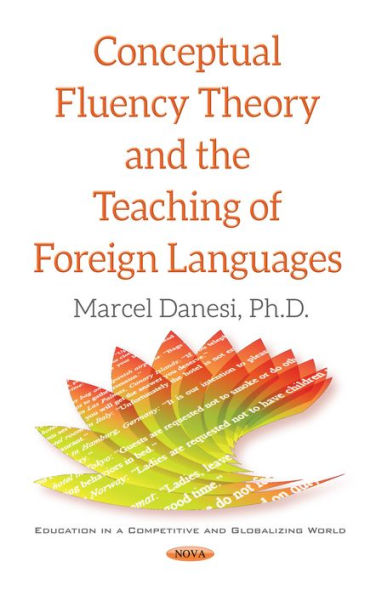Home
Conceptual Fluency Theory and the Teaching of Foreign Languages
Barnes and Noble
Conceptual Fluency Theory and the Teaching of Foreign Languages
Current price: $160.00


Barnes and Noble
Conceptual Fluency Theory and the Teaching of Foreign Languages
Current price: $160.00
Size: OS
Loading Inventory...
*Product information may vary - to confirm product availability, pricing, shipping and return information please contact Barnes and Noble
Author Biography:
Marcel Danesi is Full professor of Linguistic Anthropology and Semiotics at the University of Toronto. He has written extensively in both areas and is known in applied linguistics for having developed conceptual fluency theory. He is editor-in-chief of Semiotics and editor of several major book series with Palgrave-Macmillan, Springer, and University of Toronto Press. He was made a Fellow of the Royal Society of Canada in 1998, an honor to acknowledge his contribution to scholarship.
Book Description:
This book is the first comprehensive treatment of conceptual fluency theory, or the view that the basis of successful foreign language learning inheres in the students controlling the figurative conceptual system of the new language. Students tend to transfer their native concepts to the use of the new language, so that typical learner utterances are constructed with the words and grammar of the new language, but they reflect native language concepts. In other words, students lack “conceptual fluency” which, as studies have now shown, is the source of miscommunication and many errors when communicating in a foreign language.
The book is written by the originator of conceptual fluency theory, who takes the reader on a journey through the theoretical and empirical terrain on which the theory is founded. Above all else, conceptual fluency theory is a derivative of conceptual metaphor theory, which claims that the core of semantic systems is figurative, not literal. The implications of this claim are examined in light of previous theories and models of foreign language teaching, and then re-assessed according to the notion of conceptual fluency. Among the topics discussed and elaborated are: Conceptual calquing (imprinting the concepts of the native language onto the second language), conceptual errors (errors due to conceptual interference), conceptual grammar (the explanation of grammar in conceptual terms), and metaphorical competence (the control of the network of interrelated metaphorical concepts that allow native speakers to deliver abstract concepts fluently in speech).
The book also makes reference to previous psychological and pedagogical models, comparing them and contrasting them to the conceptual fluency model. Overall, the book constitutes a synthesis of the extensive work conducted on conceptual fluency theory since the mid-1980s, and a framework for investigating second-language acquisition in light of the research on metaphor within cognitive science.
Target Audience:
Language teachers, Linguists, Psychologists, Cognitive Scientists and Applied Linguists
Marcel Danesi is Full professor of Linguistic Anthropology and Semiotics at the University of Toronto. He has written extensively in both areas and is known in applied linguistics for having developed conceptual fluency theory. He is editor-in-chief of Semiotics and editor of several major book series with Palgrave-Macmillan, Springer, and University of Toronto Press. He was made a Fellow of the Royal Society of Canada in 1998, an honor to acknowledge his contribution to scholarship.
Book Description:
This book is the first comprehensive treatment of conceptual fluency theory, or the view that the basis of successful foreign language learning inheres in the students controlling the figurative conceptual system of the new language. Students tend to transfer their native concepts to the use of the new language, so that typical learner utterances are constructed with the words and grammar of the new language, but they reflect native language concepts. In other words, students lack “conceptual fluency” which, as studies have now shown, is the source of miscommunication and many errors when communicating in a foreign language.
The book is written by the originator of conceptual fluency theory, who takes the reader on a journey through the theoretical and empirical terrain on which the theory is founded. Above all else, conceptual fluency theory is a derivative of conceptual metaphor theory, which claims that the core of semantic systems is figurative, not literal. The implications of this claim are examined in light of previous theories and models of foreign language teaching, and then re-assessed according to the notion of conceptual fluency. Among the topics discussed and elaborated are: Conceptual calquing (imprinting the concepts of the native language onto the second language), conceptual errors (errors due to conceptual interference), conceptual grammar (the explanation of grammar in conceptual terms), and metaphorical competence (the control of the network of interrelated metaphorical concepts that allow native speakers to deliver abstract concepts fluently in speech).
The book also makes reference to previous psychological and pedagogical models, comparing them and contrasting them to the conceptual fluency model. Overall, the book constitutes a synthesis of the extensive work conducted on conceptual fluency theory since the mid-1980s, and a framework for investigating second-language acquisition in light of the research on metaphor within cognitive science.
Target Audience:
Language teachers, Linguists, Psychologists, Cognitive Scientists and Applied Linguists








